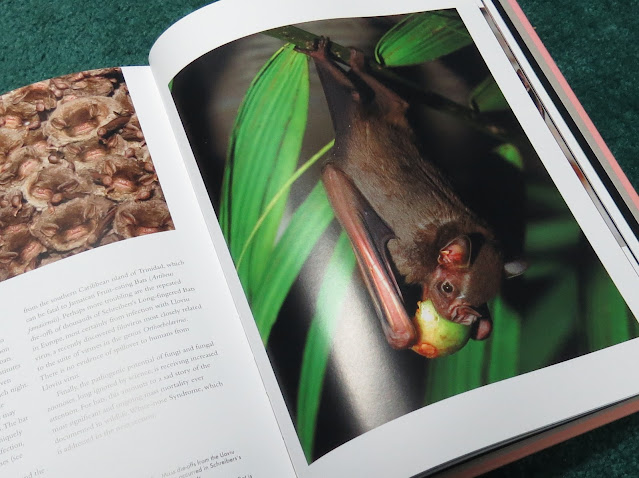It sometimes seems that barely a day goes by without the publication of another field guide to birds - or even butterflies, wildflowers and trees - yet mammals are receiving short shrift in this explosion of literature. This is especially true of bats, so it was with extra pleasure that I received this book.
It is yet another exceptional volume in the "Lives of" series by Princeton University Press, always scholarly, always accessible and authored by experts in their field.
Bats have universally had a bad rap. This volume will aid in no small measure in dispelling myths and ill-considered biases against these indispensable members of the ecosystems in which they live their lives. All bats are valuable and some are downright cute! We need to overcome our irrational fear of creatures that inhabit the night.
As is the case with all the books in this series, every page is enhanced by colour photographs of exceptional quality, some of species and behaviours rarely seen before.
Digital photography and its universal accessibility has transformed natural history books in ways that were unimaginable just a few short years ago.
Bats are the only mammals capable of powered flight, with skill, speed and dexterity matching that of birds. Aided by echolocation they are able to navigate the darkness and secure food with astonishing precision. Most species are carnivorous, but fruit-eating bats play a critical role in the pollination of some plants.
The book provides a complete examination of every facet of what makes a bat a bat, including anatomy, diet, thermoregulation, reproduction, immunity, health and zoonoses.
The final sections deal with bats and humans, and therein lies the root of many of the problems facing bats, jeopardizing the very existence of some species. In general, bats have not received favourable treatment from humans (with a few exceptions) and they are suffering from the litany of issues in the Anthropocene familiar to all. There are isolated cases where there is cause for optimism but the overall trend is reason for despair.
One would think that given the dire warnings of scientists, biologists and the stark reality we see all around us, we would be motivated to change our ways. But that seems to be an elusive dream. We plant a few trees here, restore a wetland there, all the while continuing to pollute air, soil and water, and the global temperature keeps rising. Bats suffer the consequences of human ineptitude and indifference no less than the megafauna that grabs the headlines.
DeeAnn Reeder has put together a fine account of the lives of bats, with detailed profiles of many species. I would urge everyone to embrace it with enthusiasm. You may not be a batphile (did I just create a word?) now, but you will become one after you read this book. It is for nature lovers everywhere
Factual error:
P. 232 - ....."scientists point to the rapid rise in the number of humans (roughly 2 million in 1930). Clearly this should be 2 billion.
DeeAnn M. Reeder
Hardcover - US$35.00 - ISBN: 9780691257624
288 pages - 7.5 x 9.5 inches (18.75 x 23.75 cm)
150+ colour illustrations
Publication date: 25 March, 2025


























I learned two things in the first paragraphs, bats are not birds but mammals, never really thought about that, and they can look adorable, the one eating the fruit makes me want to hold him, but I know I can't.
ReplyDeletewe in the USA are huge contributors to the destroyed environment, the streets I walk with Beau, there is one car for every person in the yard, and many have 2 people and 6 cars. there are several houses with 7 cars per driveway.. if Bob were not I'll we would be a one car house now. His truck is his love, and he only drives it 2 miles about 5 times a month, so that is good
Again a great review of a new book, David. I have very rarely seen bats here, but in Norway there are 12 species. Unfortunately, several of them are threatened with extinction. That is the way it goes for both animals and plants.
ReplyDeleteHugs and kisses, Marit
A great book about those wonderful flying mammals! It seems they are the only mammals capable of true flight.
ReplyDeleteThat is correct. Other, flying squirrels, for example, can only glide.
DeleteI didn't know they are mammals...always thought they were birds. Thanks, David, for the great review.
ReplyDeleteThe defining feature of birds is feathers. No other organism has feathers.
DeleteI reckon that would be a good book to have on bats. Gosh they are noisy creatures at dusk and so on.
ReplyDelete...they are misunderstood critters!
ReplyDeleteBats are really fascinating animals. Sadly we've had the white fuzzy nose fungus kill off so many of our bats. I used to see so many at night, and last summer I only saw a couple. And just once. They really help with the mosquito population (as you know) and I think we actually had more mosquitoes last summer. Maybe I was just imagining. Thanks for sharing.
ReplyDeleteYes, White Nose Syndrome (Pseudogymnoascus destructans) is devastating to bat populations, especially in eastern North America. Some species my go extinct.
DeleteI think this is a very good book David.
ReplyDeleteI wish you a nice weekend.
Greetings Irma
We definitely have them here...out at sunset every evening. I'm not a fan but I know they are very beneficial and we see bat boxes in our parks here so that helps. Nice review!
ReplyDeleteI am curious, why are you not a fan? And when you say beneficial - beneficial to whom?
DeleteI love that you emphasize how this book will make people embrace bats, and your enthusiasm is contagious. It's so true that reading books like these can completely shift our perception and appreciation of often-overlooked creatures.
ReplyDeleteThanks for sharing this review—I’m sure it will encourage many to learn more about bats and perhaps develop a deeper affection for them.
I hope you are having a great weekend. You are invited to read my new post: https://www.melodyjacob.com/2025/03/the-breathtaking-adventures-we-had-in-glencoe.html. Thank you!
Sorry David... But I hate bats...
ReplyDeleteHave a nice weekend !
Anna
What on Earth could have caused you to hate bats?
DeleteDavid, I can't imagine that I could ever become a "bat-phile" given that since I was very young I was told to beware of the bats and make sure to keep my hair covered or they will attack me and get into my hair!!!! I should read the book because we have bats in Pennsylvania in the summer that fly around at dusk (often when I am taking an evening walk ) and I run home. Maybe I'm actually safe to walk at sunset while they are out flying around .
ReplyDeleteI can absolutely assure you that those bats will do you no harm. In Texas bats emerging at night are a huge tourist attraction and people flock to see them.
DeleteSo many tragedies for bats! In our area, sadly, bats are carriers of rabies. If a bat has been in your indoor space with you, and you don’t capture it and have it tested, then the recommendation is that you have rabies prevention shots (a very unpleasant treatment). Nevertheless, one can see how insect-eating bats contribute to human well-being.
ReplyDeleteVery interesting review!
best… mae at maefood.blogspot.com
Not than anyone wishes to contract rabies, or be bitten by a bat or any other animal, including humans, but modern rabies injections are given in the arm, with four injections over fourteen days, with no more discomfort than any other injection. We need to get over the notion that "bats contribute to human well-being" as the measure of their existence. They are an integral and necessary part of many ecosystems and are critical pollinators for some plants.
DeleteNice review, David. I've never seen bats in person only in photos.
ReplyDeleteThere are nine species of bat in Ireland, Bill. It would not be hard to see them if you had a real desire to do so.
DeleteTan solo he visto uno desorientado, cuando comenzaba a anochecer.
ReplyDeleteUn abrazo.
This book looks amazing. I try to follow a little bit what new wildlife, science, paleo and enviro books come out but I have completely missed this one... I see that it will be released on the 25th March though, so maybe I didn't miss it after all! :D Really nice review, I'm compelled to read it. Love bats, I had nice views of some Czech species in our caves during excursion trips at university (geological trips, but still, we got to see sleeping bats, and they were so loveable... how could anyone be afraid of such cuties?).
ReplyDeleteGreat book, one which I would enjoy. I love bats they are wonderful little things. I have heard them at night over here but hard to catch with my eye or camera. Walked through a few caves with them at zoos. What an experience. Bats are not to be feared or hated!
ReplyDeleteAn enlightened point of view, Ananka.
DeleteWonderful creatures. I used to see a goodly number of them flying around our neighborhood in the late afternoons. Sadly, not so much any more, even though my next door neighbor has provided them with a lovely bat house.
ReplyDeleteBats are interesting creatures. Sadly we don't see them too often here. It seems the loss of bat populations is a dire warning for us on the planet. Nice review of the guide.
ReplyDeletePodziwiam Cię za te recenzje. Jesteś wnikliwy i analityczny. Do tej pory nie przeczytałam jeszcze książki o pszczołach, która pisałam z Twojego polecenia.
ReplyDeleteKsiążka o tyle ciekawa, że pokazuje piękne poglądowe reprezentatywne zdjęcia, co wymagało pewnie wielu czasu i wysiłku.
Bast are really interesting creatures, I used to see lots of them flying around and catching insects at dusk when I lived in my previous house, not so much here but the area is very different. One came down the chimney once, no idea how he managed to do that, but he was rescued and put outside until he recovered.
ReplyDeleteI am always very concerned about bats - certainly here in the UK - because there does not seem to be any organisation capable of keeping tabs on bat habitats in an effective way. An old stone shed which I am sure had roosting bats in it was all set to be "renovated" near us in London. It had been empty for years and so I contacted the owner and asked him to lay off the renovations till I had managed to check it out. He agreed, so I contacted the local council, which simply sent some info about roosting bats but did not respond to further questions about how one could actually report a roost at risk. I contacted the local wildlife trust, run by volunteers, and they told me to contact the nearest bat group - again, volunteers. So I did this, but they had they didn't have anyone who could visit and confirm the existence of the roost. Instead they sent me instructions to look for droppings, etc so I could decide if they were bats or not. I did think there were, of course, since this is why I'd contacted them in the first place. But my amateur opinion was certainly not enough to persuade the owner not to develop, especially since it was clear that nobody in authority cared if he did or not. So he renovated he shed, and since then I have not seen any bats locally - they used to fly around all summer. It's not really much use making people aware if the legislation is ineffectual. I am writing all this becuase I am wondering what the situation would be in a large Canadian city such as Toronto? Is it the same, do you know?
ReplyDeleteIt’s a bit of a hit and miss proposition, Jenny, but a couple of the universities will take action if contacted. The problem seems to be that there is no coordinated way to get action and often you get shunted from one phone call to another, as you experienced.
DeleteWhat fascinating animals! This looks like a wonderful book, based on your excellent review. It is sad that bats, like so many other of the creatures we share the planet with, are so at risk because of humans. We're a very creative species, but the flip side of that is that we're also so destructive--in the case of so many creatures, both at the same time. What we create for us destroys something that they rely on.
ReplyDeleteI'm not afraid of bats, in fact I like them because they can see the world upside down!!...LOL....I hope they don't eat my peaches this year......Abrazotes, Marcela
ReplyDeleteOh, i love bats, i´m batphile, too! ´cause are the world's gardeners and expert navigators in the utter darkness. While the world sleeps, they work in secret, keeping the harmony of the forest alive 💫🦇🤗
ReplyDeleteHave a nice nite
dear friend o mine!
David, what an interesting post. I’ve always thought about bats as birds. Finally, at this old age, I’m learning that bats are flying mammals … not birds. This is a great example of why I enjoy your blog so much. You are the best at giving us factual, scientific information. Thank you! Now, before reading your post, if someone had asked me … Would you like a book all about bats? Not being a batphile 😊 I might have said no. But seriously, your description and the illustrations make it seem like I may be doing business soon with Princeton University Press. Thanks for the excellent review. Before I go, I must say how much I enjoyed the delightful comment you left for me on my newest post. I love what you said about the flat-earthers … you are so right … they have all congregated in Washington DC … tRump is the ultimate flat-earther! OMG, I’ll be smiling about that for days! 😊 John
ReplyDeleteVery interesting review. Years ago we saw many more bats than now.
ReplyDeleteI'm sorry I didn't come to visit you sooner, but this week a technical problem kept me out of service...
Un abrazo David
Great review David, you and the author do a great service for the much maligned bat. The more we are educated the better we understand the importance of them.
ReplyDeleteWhen I used to walk my dog at dusk in at midnight I could see the bats flying around the light poles. Some of the residents here use the wood shop to build bat houses... We have several sprinkled around the community. Interesting and important animals!xxoo
ReplyDeleteNunca he sido entusiasta de los de los murciélagos, no me han gustado. Ahora leyendo Ia reseña que haces del libro , puede que cambie de opinión. Gracias David.
ReplyDeleteBuena semana y marzo para vosotros.
Un abrazo.
Hello David :)
ReplyDeleteExpressive and enthusiastic narration David thank you.This book seems like the perfect way to introduce bats to the uninitiated, like myself, although I did know they are mammals and not birds.:) I do know a little about them, but not nearly enough. I am used to seeing them, and I can't tell you how many times bats have found their way inside my house, and found their way out again as the doors are always open on warm summer evenings. It's sad to know these little creatures are in decline for I know how valuable they are to ecosystems and as pollinators, regretfully however I haven't been doing much reading because of the cataracts, and would struggle with the small print.
Hugs and kisses
Sonjia.
Querido David me encantan los murciélagos, aquí los más abundantes son los orejudos (Plecotus auritus) son muy pequeños, con enormes orejas y bastante guapos, es fácil verlos en los agujeros y en las losas de las casas. Aquí no tienen demasiados enemigos y hay muchos. También hay Rhinolophus (murciélago de herradura) estos son mucho más grandes y menos abundantes. Como siempre la reseña estupenda. Es un libro muy interesante y para tener en cuenta. Un enorme abrazo para ti y para Miriam.
ReplyDelete... and now I know they are a mammal :)
ReplyDeleteAll the best Jan
Siempre vi murciélagos por el pueblo, antes había muchos más que ahora. En el jardín los suelo ver en verano y me gusta porque se comen los mosquitos. Abrazos.
ReplyDeleteThanks David - another great recommendation ... I particularly credit you with obviously having read through your reviews - hence the notes where an obvious mistake has been made which you highlight for us. Cheers Hilary
ReplyDeleteThanks, Hilary.
Delete